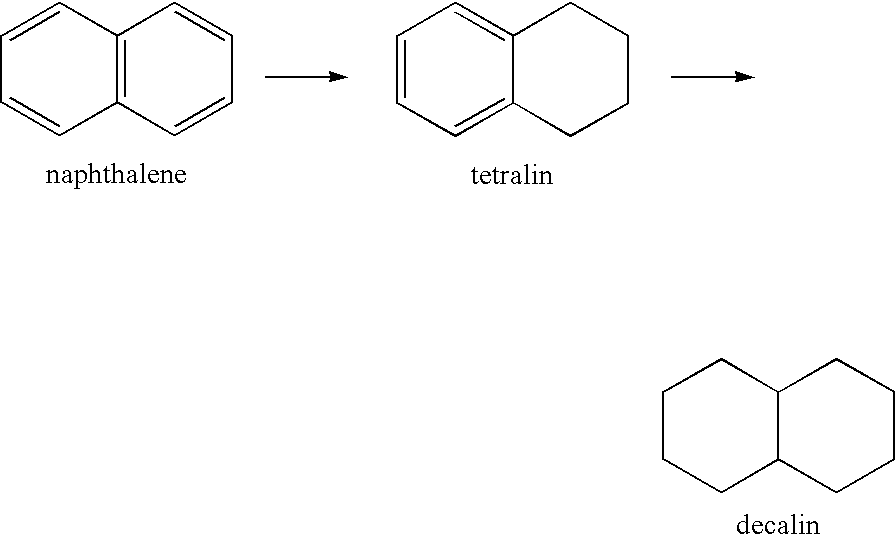Transition metal phosphides and hydrotreating process using the same
a technology of transition metal phosphides and hydrotreating process, which is applied in the direction of catalyst activation/preparation, physical/chemical process catalysts, chemistry apparatus and processes, etc., can solve the problem of undesirable reaction of hydrogenation
- Summary
- Abstract
- Description
- Claims
- Application Information
AI Technical Summary
Problems solved by technology
Method used
Image
Examples
example 1
Preparation of Ni2P / (Mo / Al2O3)
[0025]The phosphide powder was prepared as follows: nickel chloride and red phosphorus were mixed; then polyacrylamide was added in weight ratio P:polyacrylamide 3.5:1. The vessel was filled with ethylenediamine resulting in the molar ratio Ni:P:en=1:11:70. The reaction took place in a stirred reactor at 180° C. for 4 hours. The formed powder was filtered and dried overnight at room temperature. The powder X-ray diffraction of the product matched that of Ni2P, PDF 03-0953. A slurry was prepared from the nickel phosphide powder in water and was sonicated with ultrasonic probe for 30 minutes. Then it was added to a support prepared by the impregnation of ammonium heptamolybdate on alumina, followed by calcination of 300° C. for 2 hours in air. The Ni2P and Mo / Al2O3 water based slurry was placed covered on a hot plate and evaporated to dryness with occasional stirring. The resulting product was dried at 100° C. for 24 hours. This sample was identified as s...
example 2
Preparation of (Mo / Ni2P) / Al2O3
[0026]Some of the nickel phosphide described in Example 1 was impregnated with ammonium heptamolybdate solution then dried at 50° C. for 19 hours and finally calcined at 300° C. for 2 hours. Next, the resulting material was suspended in 2-propanol-methanol-water solution (1:1.5:1 by weight) and meshed gamma alumina was added. The slurry was covered and placed on a heating plate at a low temperature setting of 50-60° C. More water was added after 12 hours and the content of the beaker was reslurried. The heating continued for a total of 44 hours. In the final step the solid was dried at 120° C. for 24 hours in air filled oven. This sample was identified as sample B.
[0027]A second sample was also prepared using the above procedure with approximately half of the metal loading of the first catalyst as is shown in Table 2. This sample was identified as sample C.
example 3
Preparation of Mo / (Ni2P / Al2O3)
[0028]The nickel phosphide powder from Example 1 was suspended in 2-propanol-methanol-water solution (1:1.5:1 by weight) and meshed gamma alumina was added. The Ni2P / Al2O3 mixture was dried in about 24 hours to dryness. The molybdenum was next added by impregnation with a water based ammonium heptamolybdate solution. The resulting slurry was heated while covered and occasionally stirred to dryness slowly for about 30 hours. There was no calcination step involved in this example. This sample was identified as sample D.
PUM
| Property | Measurement | Unit |
|---|---|---|
| wt. % | aaaaa | aaaaa |
| wt. % | aaaaa | aaaaa |
| temperature | aaaaa | aaaaa |
Abstract
Description
Claims
Application Information
 Login to View More
Login to View More - R&D
- Intellectual Property
- Life Sciences
- Materials
- Tech Scout
- Unparalleled Data Quality
- Higher Quality Content
- 60% Fewer Hallucinations
Browse by: Latest US Patents, China's latest patents, Technical Efficacy Thesaurus, Application Domain, Technology Topic, Popular Technical Reports.
© 2025 PatSnap. All rights reserved.Legal|Privacy policy|Modern Slavery Act Transparency Statement|Sitemap|About US| Contact US: help@patsnap.com


